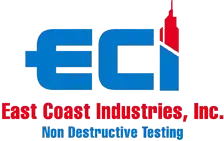Ultrasonic Pipe/Tank Testing
Feel free to contact us now
Experience Unmatched Accuracy With Our Ultrasonic Pipe Testing Services
Ever wonder how you can find hidden defects or corrosion in your pipes without actually breaking through them? East Coast Industries, Inc. makes that possible via ultrasonic pipe testing (UT pipe testing). Our ultrasonic pipe testing services assist New York City and New Jersey commercial buildings to find interior defects and corrosion before they become expensive issues. We provide accurate data without compromising your systems, utilizing innovative nondestructive testing (NDT) methods. Our team uses advanced tools such as the Panametrics 37DL Plus Ultrasonic Thickness Guage for ultrasonic pipe thickness testing. This provides high-resolution data for detecting flaws and corrosion in hard-to-reach areas, ensuring that we identify potential problems efficiently.
Ultrasonic pipe inspection (ut pipe inspection) works by sending high-frequency sound waves through the material and picking up the reflections from the other side of the pipe. This process allows us to detect irregularities such as corrosion, fissures, or wall thinning. Through the examination of these reflections, our experts can identify flaws and evaluate the general pipe integrity. Early intervention and repair are made possible by this very successful approach for spotting hidden flaws unseen to the naked eye.
In the world of commercial infrastructure, undetected pipe failures can lead to leaks, structural damage, and costly downtime. Utilizing our ultrasonic pipe testing services allows property managers and facility operators to proactively maintain their systems, therefore guaranteeing safety, efficiency, and industry compliance with standards. Our knowledge will help you to maximize the lifetime of your infrastructure and prevent unplanned disturbances.
Ensuring the integrity of your piping systems can help you to avoid possible failures. For exact and dependable ultrasonic pipe testing, trust East Coast Industries, Inc. Call us right now to set up your inspection.
Check out our other pages to learn more about services like
infrared testing, steam trap testing, vibration analysis, and power monitoring.
Enhance Safety And Efficiency With Our Superior Ultrasound Technology Solutions
Innovation at East Coast Industries, Inc. meets accuracy with ultrasonic technology—a revolutionary approach to non-destructive testing (NDT). We can find interior flaws and gauge wall thickness without sacrificing the integrity of your business building by using sound wave power. We help companies to avoid costly failures and extend the lifetime of vital systems.
Our knowledgeable staff at East Coast Industries, Inc. utilizes the Panametrics 37DL Plus Ultrasonic Thickness Gauge to precisely measure wall thickness and identify areas of corrosion or wear that could lead to future failures. These tools let us examine intricate infrastructure like pressure vessels and pipelines. High-resolution data captures help us to spot possible flaws early on, stop expensive breakdowns, and improve general system performance. Working with us will provide you access to high-quality, non-destructive testing solutions protecting your assets and reducing downtime.
Our knowledge at East Coast Industries, Inc. goes beyond spotting errors. We offer thorough investigation and practical advice to enable you to decide on repairs and maintenance with knowledge. With the precise information acquired from our cutting-edge ultrasonic testing techniques, you may boldly solve structural problems and increase the lifetime of your vital systems.
Count on East Coast Industries, Inc. to offer your commercial property the most dependable ultrasonic technology options. Get in touch right now to arrange an inspection and protect your infrastructure.
Ensure Safety with Precision Testing
Our precise, non-intrusive inspections help the Tri-State area detect issues early, ensuring safety, compliance, and long-term durability. Schedule your assessment today!
Ultrasonic Testing For NYC And NJ Commercial Properties: Accuracy You Can Rely On
Serving customers nationwide, East Coast Industries, Inc. takes great satisfaction in providing innovative ultrasonic testing solutions to protect the commercial infrastructure of New York City and New Jersey. High-frequency sound waves allow us to identify internal flaws and corrosion precisely without damaging your important systems. Maintaining structural integrity and preventing expensive breakdowns depend on this non-destructive testing (NDT) approach.
The great advantage of ultrasonic testing is its efficiency for corrosion monitoring. Our experts can find thinning, cracks, and other defects compromising the strength of pipes and tanks, by running sound waves through metal surfaces and studying the reflections. The early identification of problems made possible by this approach helps to lower downtime and repair costs while increasing the lifetime of your piping systems.
Our on-site pipe thickness tester will rely on the Panametrics 37DL Plus Ultrasonic Thickness Gauge for accurate measurements of pipe and tank wall thickness to ensure that even the most challenging structures are assessed with precision for potential issues. Our knowledge of ultrasonic thickness testing helps us to estimate material degradation—even in difficult settings. We provide tailored solutions that meet the particular requirements of every project given NYC's aged infrastructure and NJ's industrial facilities provide particular difficulties. Our sophisticated equipment guarantees exact results for anything from manufacturing facilities to power plants to high-rise structures.
Our goal at East Coast Industries, Inc. is to safeguard your assets with the most reliable ultrasonic testing solutions. Learn more
about us
now to find out how we could assist you in keeping your infrastructure intact and preventing unplanned breakdowns.
